Portokalopita is the easy make-ahead dessert recipe that dreams are made of. A decadent (butter-free) custard cake is layered with crisped phyllo dough, and then finished with fragrant Honey-Orange Syrup.

I was first introduced to this delicious Greek Orange Cake, called Portokalopita, while on a Mediterranean Dish community trip last summer. Our group of 25 was taking a traditional cooking class in the heart of Athens, where we learned to make a lunch of Greek classics.
We started the class by baking the cake, layering the rich custard with crispy phyllo dough and baking until it was beautifully golden. While it soaked in the delicate Honey-Orange Syrup, we put together a spread of Zucchini Fritters, Moussaka, and more.
Even after our feast was over, we couldn’t get enough of this cake with its tender crumb, delicate sweet-tart flavor, incredible orange zest aroma, and layers of custard-soaked phyllo dough. Everyone was so enamored with this dessert that I promised to work on a homemade version to share here on the site. So here we are; finally!
Here is the gist of this cake: Torn phyllo strips that are fully dried (either overnight at room temperature or via toasting in the oven) then mixed into a yogurt and orange custard and baked until golden brown. For the best flavor, you must pour the syrup all over the cake as soon as it comes out of the oven and allow the cake to fully absorb the syrup. This is why I love making this dessert ahead of time.
Table of Contents

What is in Portokalopita?
One of the things I love most about the Mediterranean way is that we don’t believe in waste. We turn stale bread into Salmorejo, for example. Leftover Pita becomes Fatteh, or the Egyptian version of nachos.
Portokalopita was likely born of the same frugal and flavorful mindset—a way to use leftover phyllo scraps from making Greek classics like Spanakopita. And, though this is a traditional Greek recipe, the ingredients are happily available at just about any supermarket. You’ll need:
- Oranges: Look for the juiciest, most aromatic oranges you can find. You’ll use both the zest and the juice so opt for untreated oranges if you can.
- Honey: I prefer a light and delicate honey that will sweeten the cake without competing with the oranges, like our Greek Alfa Honey from Crete.
- Granulated sugar not only sweetens the syrup and cake, it also helps to incorporate air into the eggs, giving the cake a light and fluffy texture.
- Phyllo dough brings an element of surprise to this easy orange cake, adding a unique crispy texture to the crumb. I use store-bought phyllo dough and thaw it in my fridge overnight.
- Eggs: Add richness and bind the cake together.
- Baking powder reacts with the moisture and heat to produce carbon dioxide, which makes the cake rise and become fluffy.
- Extra virgin olive oil adds flavor, richness, and makes for an incredibly tender crumb (see “Ingredient Spotlight” below for more details).
- Yogurt: Use plain whole milk yogurt.
- Vanilla extract: Adds depth to the orange cake’s flavor. If you don’t have any on hand, rum is a good substitute for vanilla in baking.
- Salt: A touch of salt brings out the flavor, even in baking and sweet treats.
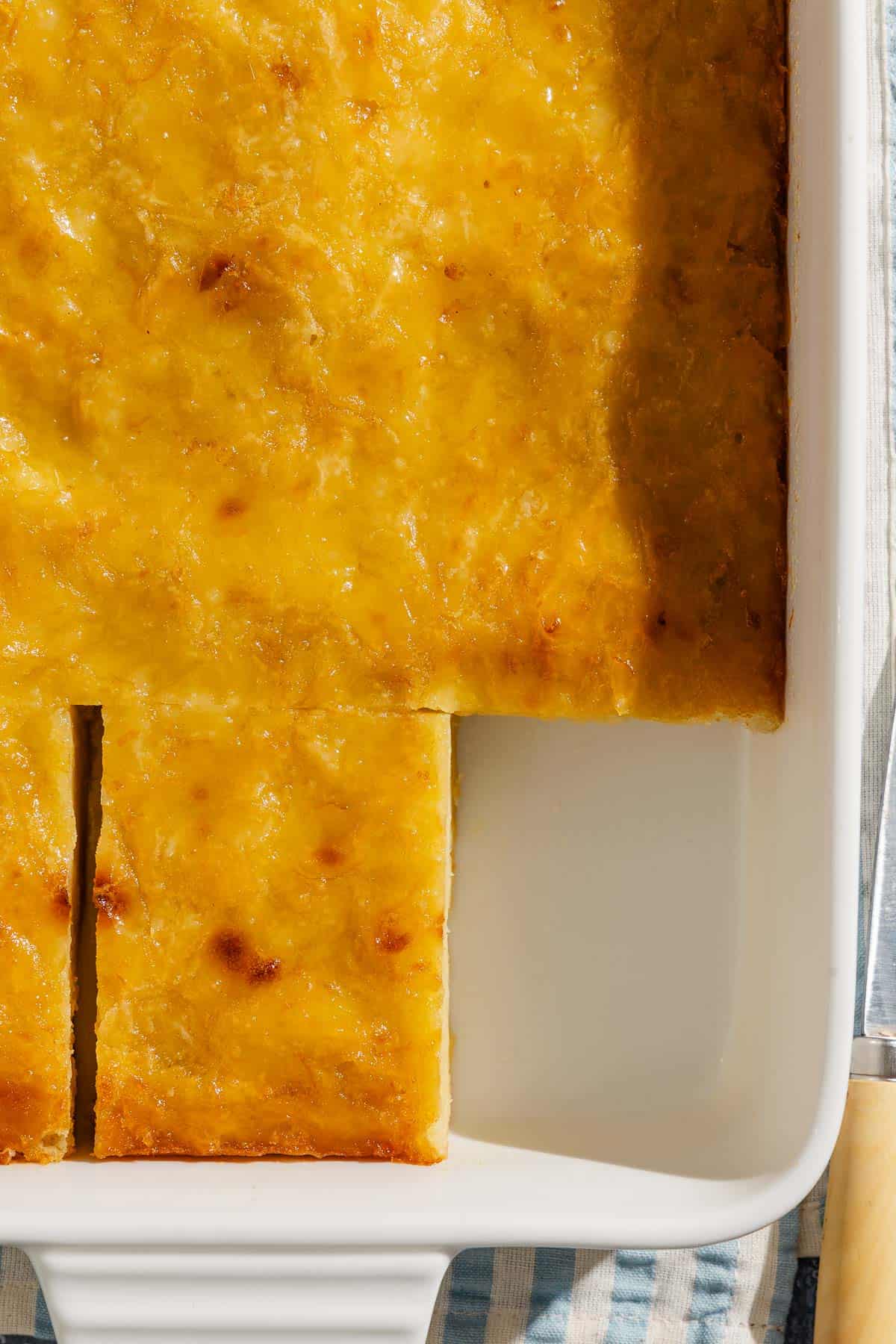
Ingredient Spotlight
There is no butter in this Greek orange cake recipe, and that’s intentional. That’s not just because olive oil is a heart-healthy, Mediterranean diet-friendly fat, though that’s a bonus! Swapping in extra virgin olive oil adds a more nuanced flavor, with fruity and savory notes that complement the sweet-tart orange flavor.
It’s also liquid at room temperature, which ensures the cake stays moist for days rather than drying out. Just be sure to use a pleasantly smooth olive oil—I would avoid anything too bitter or spicy.
- READ MORE: Guide to Baking with Olive Oil
- RECOMMENDED FOR THIS RECIPE: Buttery-smooth varieties, like our Arbequina from California or Italian Nocellara.
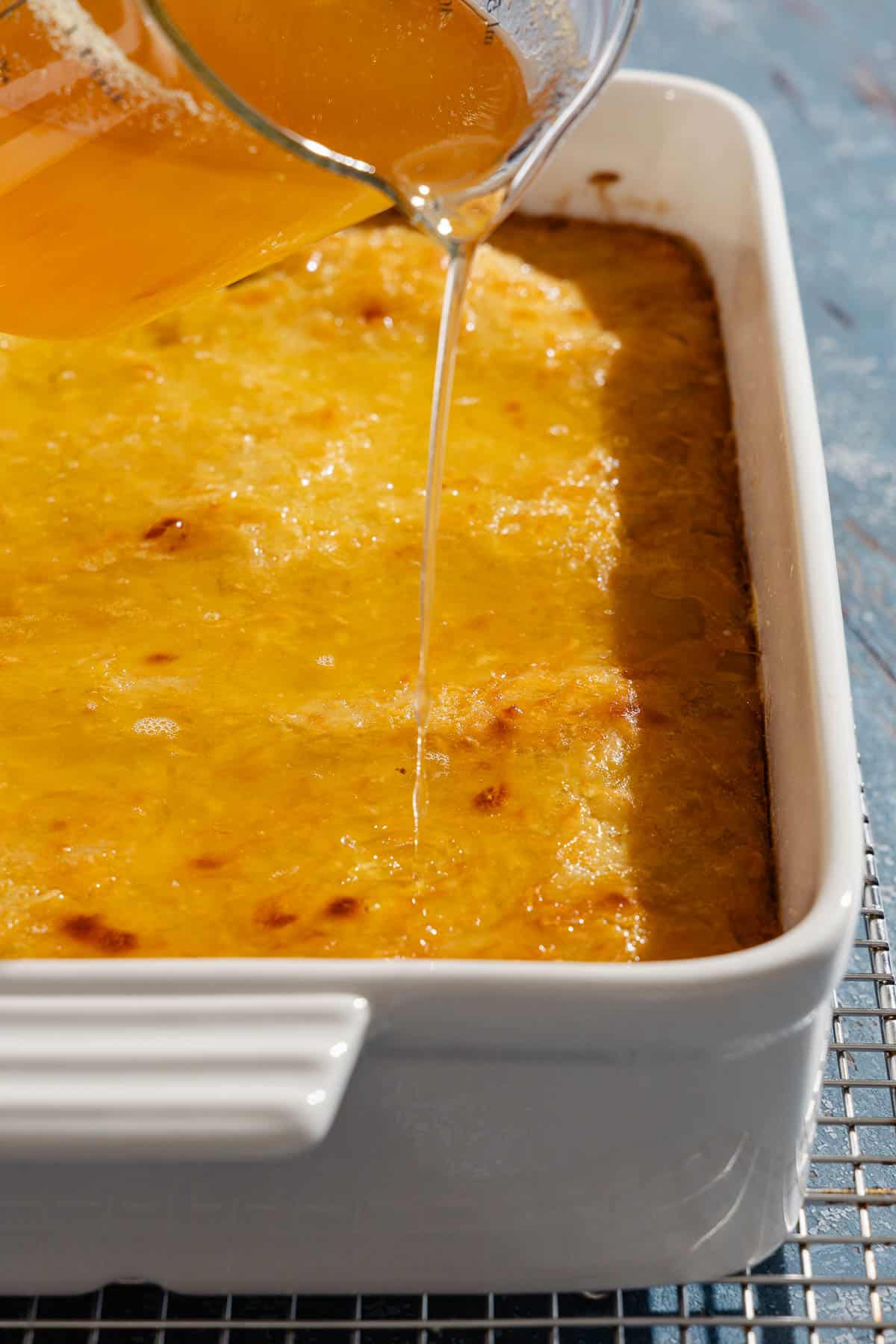
How to Make Portokalopita
The key to Portokalopita’s unique texture is to first dry the phyllo dough. Some recipes have you leave it on the counter, but I prefer to do this in the oven so it gets nice and crisp. This allows it to soak up the batter without getting soggy.
Make the Honey-Orange Syrup
- Get ready: Heat the oven to 350°F. Lightly oil a (9 1/2 x 14-inch) baking pan.
- Meanwhile, prepare the syrup. Use a sharp knife or peeler to slice off the peel of 1 orange, leaving as much white pith behind as possible. Add the peel to a medium saucepan, along with 1/2 cup freshly squeezed orange juice, 1 1/2 cups water, 1 cup honey, and 1/2 cup sugar. Bring to a boil over medium-high heat, stirring until the sugar has dissolved, then lower the heat and allow the mixture to simmer until thickened slightly, about 5 minutes. Remove from the heat and set aside to cool completely.
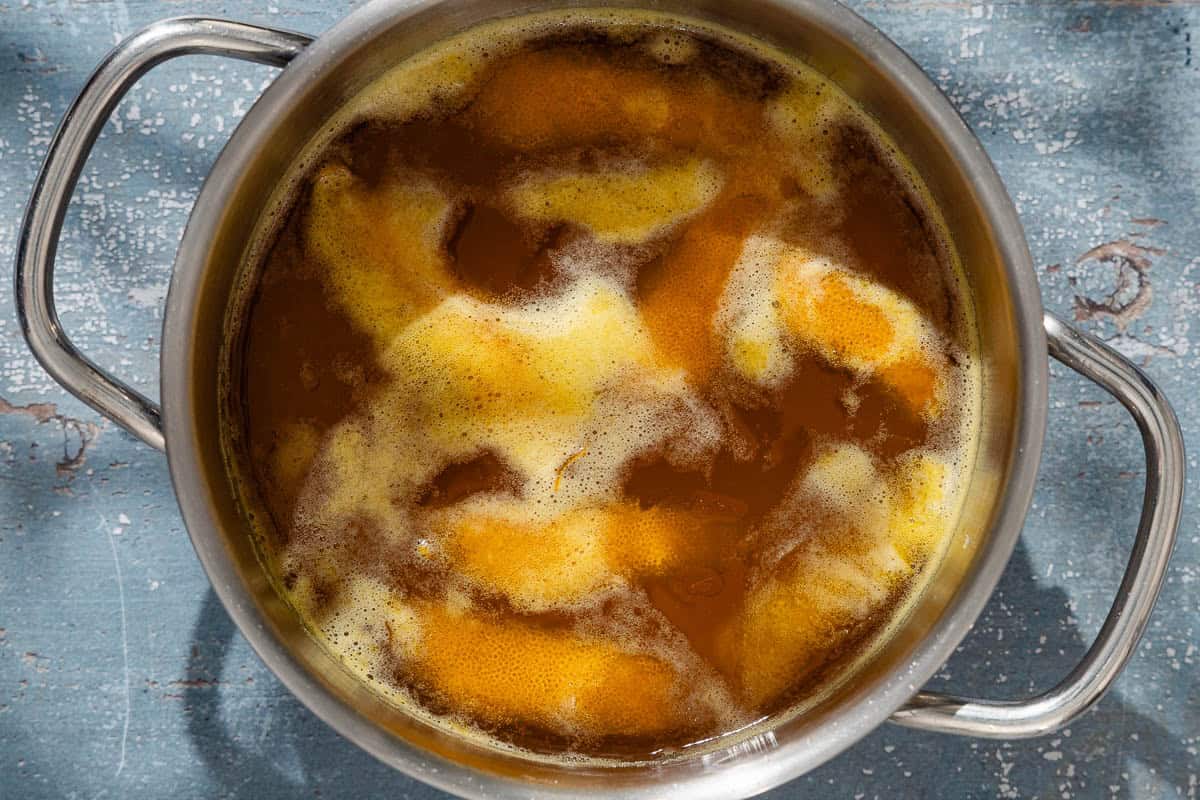
Make the Greek Orange Cake
- Toast the phyllo. Slice or tear 1 pound of phyllo dough into thin pieces. Spread the pieces on a large baking sheet or two without overlapping. Bake in the hot oven, tossing occasionally, until the phyllo strips have dried and crisped up a bit, about 10 minutes or so. They should have a little bit of color but they should not fully brown. Remove from the oven (leave the oven on).
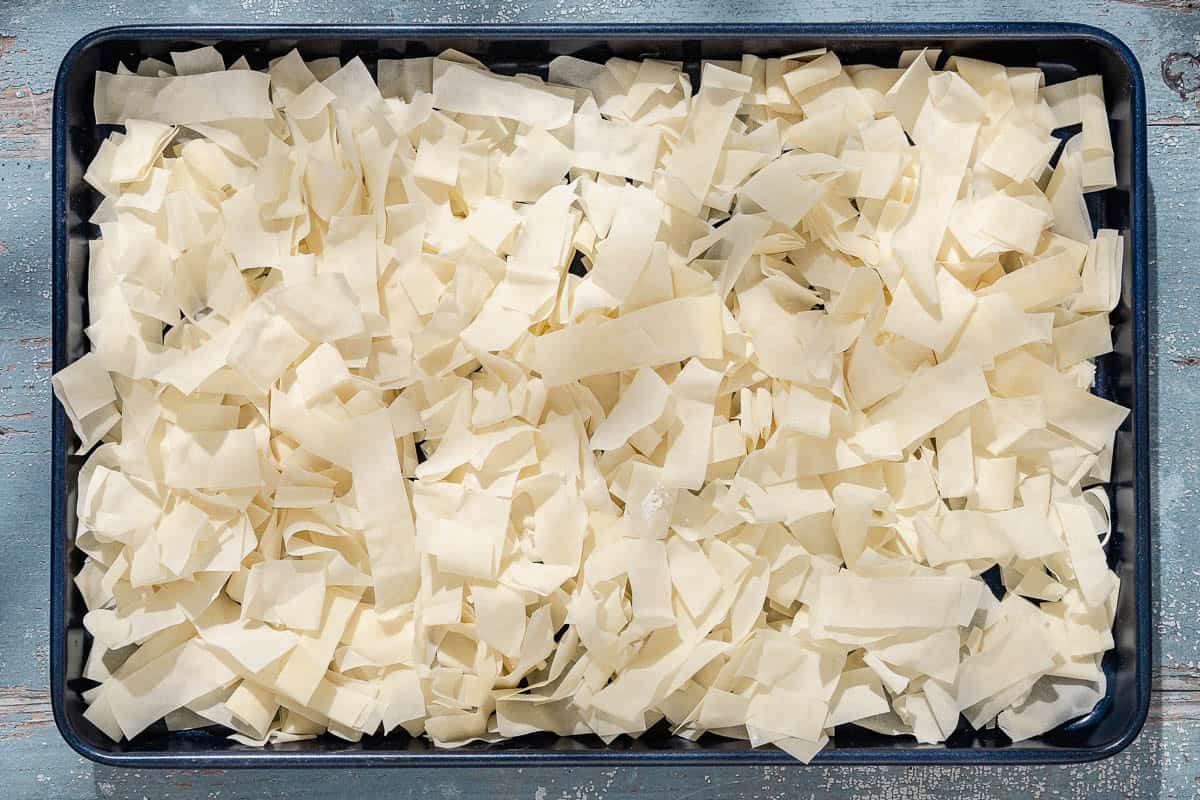
- Prepare the Orange Cake batter. In a large mixing bowl (the largest you have), add 5 large eggs and 3/4 cup granulated sugar. Use an electric hand mixer on medium speed to beat the eggs and sugar until the mixture thickens and turns pale yellow. Add 1 tablespoon baking powder and beat again to incorporate. Add 1 teaspoon vanilla extract, 1/4 teaspoon salt, 1 cup olive oil, 1 cup yogurt, the zest of 2 large oranges and 1 1/4 cups juice. Whisk or beat lightly until the mixture is well combined.

- Add the phyllo to the batter. Add the dried phyllo strips, one handful at a time, folding until the phyllo is submerged in the batter. Transfer the batter to the prepared baking pan.

Bake and Soak
- Bake the cake. Bake on the center rack of the heated oven for about 45 minutes to 1 hour, or until the cake has a lovely golden brown color and a skewer inserted into the center comes out clean. Remove from the oven.
- Soak the cake. Remove the cake from the oven and use a skewer to poke holes all over it. Immediately pour the cooled honey-orange syrup evenly over the cake. Set aside for at least 1 hour (or overnight) to allow the cake to fully absorb the syrup. Slice the Portokalopita into 12 pieces and serve.
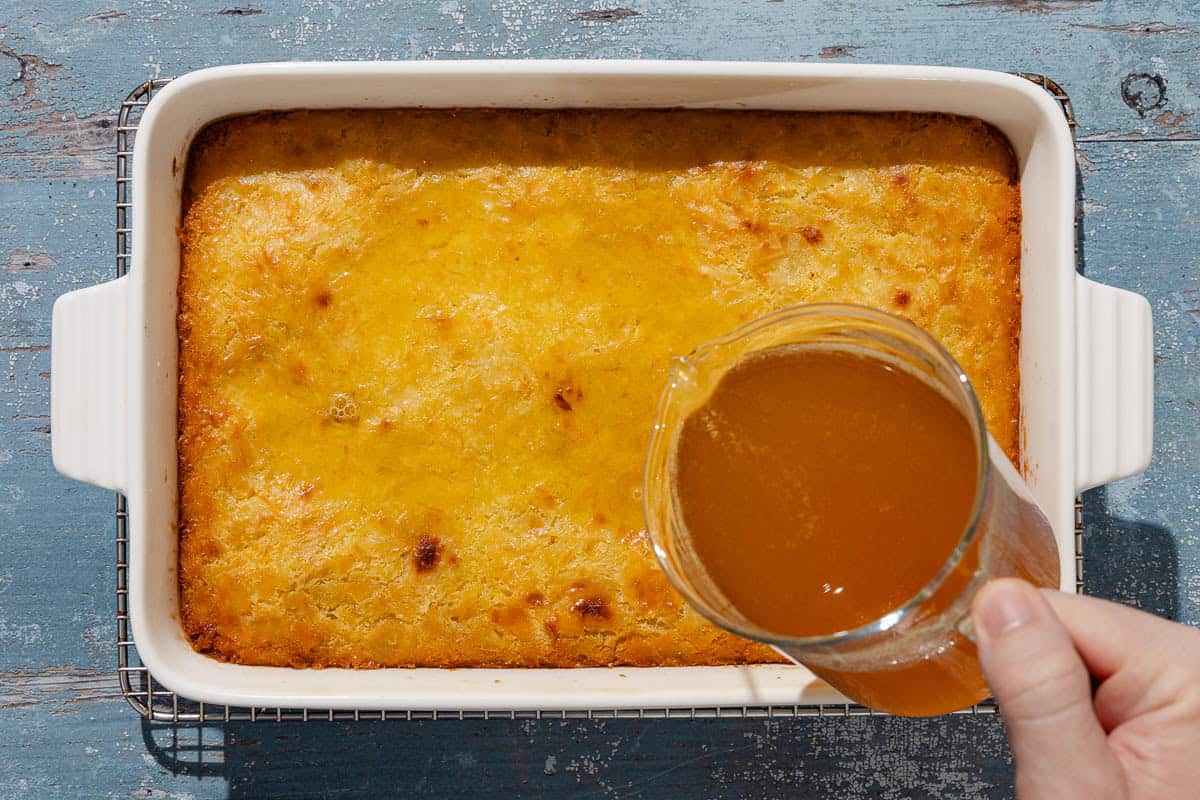
Ways to Mix it Up
I love to keep my Portokalopita simple so the orange flavor can really shine, but you can certainly spruce it up if you’d like. Some ideas:
- Add spice: Add a cinnamon stick to the Honey Orange Syrup as it stews.
- Add a garnish: If you’d like to make it just a touch “fancier” top with Candied Orange Peel and/or a sprinkle of chopped pistachios.
- Use other varieties of citrus: Though it’s not traditional, you can experiment with other citrus. Try a touch of grapefruit for a bitter note, or use blood oranges if you have a strong sweet tooth (you may want to tone down the sugar a tad, as blood oranges tend to be much sweeter).
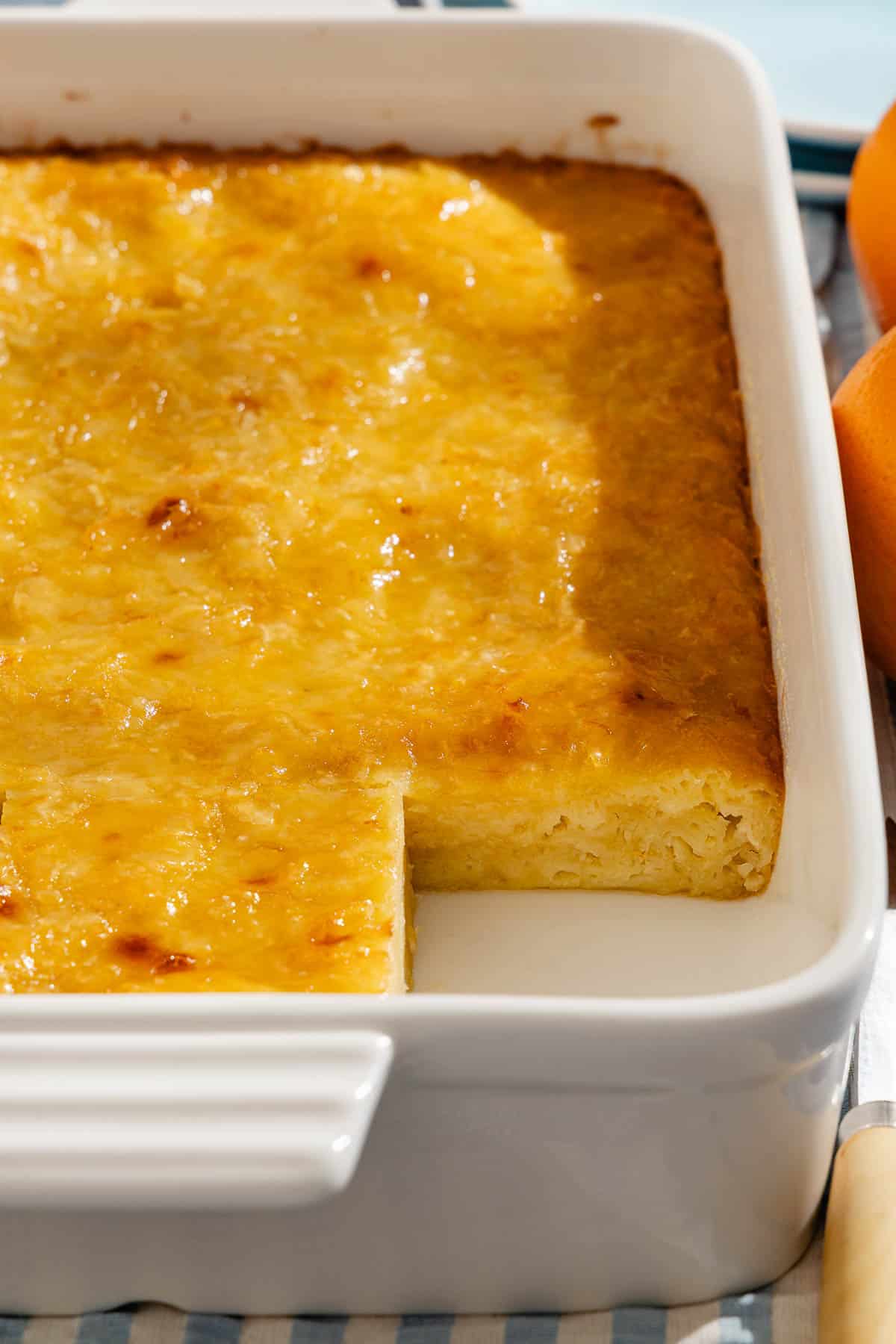
What to Serve with Portokalopita
The Greek orange cake is all you need for a decadent dessert, on its own or with a cup of coffee or herbal Greek Mountain Tea on the side. To make a Greek-style feast fit for a holiday or special occasion, serve as a finale to Pan Seared Lamb Chops with Spanakorizo (Greek Spinach Rice).
Start the evening with Kritsinia (Crispy Sesame Breadsticks) and a dip of some kind—I’ve been partial to Tirokafteri (Spicy Greek Feta Dip) lately.
More Greek Dessert Recipes
Browse all Mediterranean recipes.
Visit Our Shop.

Portokalopita (Greek Orange Cake)
Ingredients
For the Honey-Orange Syrup
- 1/2 cup freshly squeezed orange juice (from about 2 medium oranges)
- 1 1/2 cups water
- 1 cup honey
- 1/2 cup granulated sugar
For the Orange Cake
- 1 pound phyllo dough, thawed and at room temperature (see note)
- 5 large eggs
- 3/4 cup granulated sugar
- 1 tablespoon baking powder
- 1 cup extra virgin olive oil
- 1 cup whole milk plain yogurt
- Zest of 2 large oranges
- 1 1/4 cups freshly squeezed orange juice (from about 5 medium oranges)
- 1 teaspoon vanilla extract
- 1/4 teaspoon salt
Instructions
-
Get ready: Heat the oven to 350°F. Lightly oil a (9 1/2 x 14-inch) baking pan.
-
Meanwhile, prepare the syrup. Use a sharp knife or peeler to slice off the peel of one orange, leaving as much white pith of behind as possible. Add the peel to a medium saucepan, along with the orange juice, water, honey, and sugar. Bring to a boil over medium-high heat, stirring until the sugar has dissolved, then lower the heat and allow the mixture to simmer until thickened slightly, 5 minutes. Remove from the heat and set aside to cool completely.
-
Toast the phyllo. Slice or tear the phyllo into thin pieces. Spread the pieces on a large baking sheet or two without overlapping. Bake in the hot oven, tossing occasionally, until the phyllo strips have dried and crisped up a bit, about 10 minutes or so. They should have a little bit of color but they should not fully brown. Remove from the oven (leave the oven on).
-
Prepare the Orange Cake batter. In a large mixing bowl (the largest you have), add the eggs and sugar. Use an electric hand mixer on medium speed to beat the eggs and sugar until the mixture thickens and turns pale yellow. Add the baking powder and beat again to incorporate. Add the olive oil, yogurt, orange zest and juice, vanilla extract, and salt. Whisk or beat lightly until the mixture is well combined.
-
Add the phyllo to the batter. Add the dried phyllo strips, one handful at a time, folding until the phyllo is submerged in the batter. Transfer the batter to the prepared baking pan.
-
Bake the cake. Bake on the center rack of the heated oven for about 45 minutes to 1 hour, or until the cake has a lovely golden brown color and a skewer insured into the center comes out clean. Remove from the oven.
-
Soak the cake. Remove the cake from the oven and use a skewer or metal fork to poke holes all over the top. Immediately pour the cooled honey-orange syrup evenly over the cake. Set aside for at least 1 hour (or overnight) to allow the cake to fully absorb the syrup.
-
Slice and serve. Slice the Portokalopita into 12 pieces and serve.
Notes
- Shop this recipe: Visit our shop to browse quality Mediterranean ingredients including the olive oil and honey used in this recipe.
- To prep store bought phyllo dough: Take the phyllo dough out of the fridge 1 hour before using. If your dough is frozen, thaw first in your refrigerator overnight.
- For a spiced version: Add a cinnamon stick to the Honey Orange Syrup.
Nutrition
Greek Honey – Thyme, Forest & Wild Herbs
A drizzle of this high quality Greek honey adds the perfect finishing touch to your Wrapped Figs.

The post Portokalopita (Greek Orange Cake) appeared first on The Mediterranean Dish.



